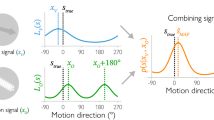Abstract
This paper proposes a new neural network model for visual motion detection. The model can well explain both psychophysical findings (the changes of displacement thresholds with stimulus velocity and the perception of apparent motion) and neurophysiological findings (the selectivity for the direction and the velocity of a moving stimulus). To confirm the behavior of the model, numerical examinations were conducted. The results were consistent with both psychophysical and neurophysiological findings.
Similar content being viewed by others
References
Baker JF, Petersen SE, Newsome WT, Allman JM (1981) Visual response properties of neurons in four extrastriate visual areas of the owl monkey (Aotus trivirgatus): a quantitative comparison of medial, dorsomedial, dorsolateral, and middle temporal areas. J Neurophysiol 45:397–416
Barlow HB, Levick WR (1965) The mechanism of directionally selective units in rabbit's retina. J Physiol London 178:477–504
Cynader M, Chernenko G (1976) Abolition of direction selectivity in the visual cortex of the cat. Science 193:504–505
Douglas RJ, Martin KAC, Whitteridge D (1989) A canonical microcircuit for neocortex. Neural Comput 1:480–488
Fukuda T (1979) The functional difference between central and peripheral vision in motion perception. J Inst Television Eng Jpn 33. 6:479–484
Mikami A, Newsome WT, Wurtz RH (1986a) Motion selectivity in macaque visual cortex. I. Mechanisms of direction and speed selectivity in extrastriate area MT. J Neurophysiol 55:1308–1327
Mikami A, Newsome WT, Wurtz RH (1986b) Motion selectivity in macaque visual cortex. II. Spatiotemporal range of directional interactions in MT and VI. J Neurophysiol 55:1328–1339
Shimodaira Y, Hiwatashi K (1987) Perception of motion in successively displayed pattern stimuli. Trans Inst of Electron, Inform Commun Eng (Jpn) J70-A:102–109
Author information
Authors and Affiliations
Rights and permissions
About this article
Cite this article
Hirahara, M., Nagano, T. A neural network model for visual motion detection that can explain psychophysical and neurophysiological phenomena. Biol. Cybern. 68, 247–252 (1993). https://doi.org/10.1007/BF00224859
Received:
Accepted:
Issue Date:
DOI: https://doi.org/10.1007/BF00224859




